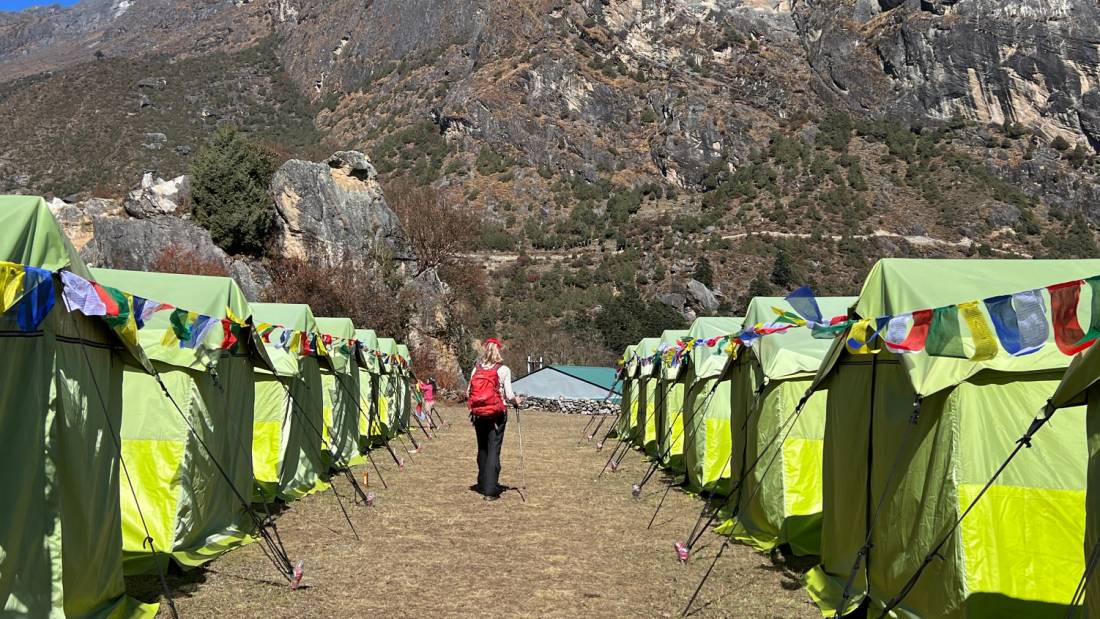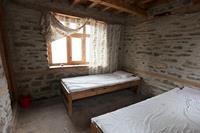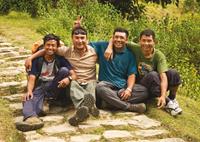Tossing up between going on a teahouse trekking trip and a camp-based trek in Nepal? We sift through some myths and drill down into the facts on how the two really compare.
While teahouse-based treks in the Himalaya may incorporate some eco-friendly measures, often these ‘green’ initiatives are not as 'green' as they appear.
And what about supporting local communities? How do teahouses compare to eco camps?
What about eco camps?
Eco campsites have a small environmental footprint. Kerosene or gas are the fuel used for cooking. Dried yak dung is used for heating common areas, which are constructed using stone, cement and tin, rather than wood. Where it is necessary to use timber for construction, it is sustainably sourced from Nepal's controlled forestry suppliers. As well as these huge environmental benefits, tent life in the Himalaya has the added benefit of encouraging a connection with nature and the outdoors.

Showers are powered by hydro, gas, or solar heating systems and bathrooms are housed with flushing, composting and septic, western-style toilets and hand basins. All non-biodegradable refuse – paper and plastic – is incinerated in a clean and complete burn, with non-combustible waste safely carried out to the nearest city for responsible disposal.
There's no doubt that the environmental impact of our camp-based treks are smaller than standard lodge-based and teahouse trekking trips.
When there is no other option available - when land permits do not allow wilderness camping in certain areas - you do stay in ecolodges on the World Expeditions trips. In this situation, we choose to stay in those which will have minimal environmental impact and are in line with our responsible travel policy and use the World Expeditions supplied incinerators for rubbish disposal where appropriate.
Myth 1: Teahouses spread tourism dollars to more locals than eco campsites
Teahouses are often run by locals, but they are not a traditional part of the culture as they were built to cater for the growth in tourism. Those lucky enough to own a teahouse business are fortunate to have a source of income that is often restricted to the small group of locals they employ.
What about camping-based treks?
Camp-based treks spread money more widely to sections of the community that don’t have the resources to own a teahouse and employ around 25% more local people than on a teahouse trek.
The regular crew employed on every trek consists of a guide, assistant guides, cook and kitchen crew, trekking Sherpas and porters. Our wilderness camps require an even bigger crew of porters, with more gear to carry.
As well as the employment opportunities that these treks provide, the semi-permanent campsites are situated on land leased to us annually, with tourism dollars going directly to local land owners, who are also paid to operate and maintain the campsites. This not only provides a steady income for local families, it also reduces the effects of seasonality by extending the season, with guides and porters working during the off-season to set up and maintain the camps.
Expect on all our treks to be served up with healthy and nutritious meals from locally grown food, which are sourced as we trek. By purchasing fresh produce and supplies from a range of communities along the trail, we're helping provide an income source to farmers, further benefitting the local economy. It's a win-win situation!
As members of the International Porter Protection Group and the International Mountain Explorers Connection, we operate our treks to ensure the health and well-being of porters globally. In Nepal, a good working wage is provided, which is regulated by the Trekking Agents Association of Nepal and the Labour Union of Nepal, as well as providing life insurance and income protection insurance for all our porters. All porters and staff are afforded the same level of care that our travellers can expect.
What's more, our guides are trained well above the industry standard, receiving extensive first aid and medical training from Dr Ross Anderson of Adventure Medical Consulting, and on the field training courses on leadership, group management and responsible travel practices. This training teaches life skills which can assist locals in other career paths, such as transitioning from a porter to a guide or teaching English.
Myth 2: It’s more sanitary to stay in a teahouse than at a campsite
With the revolving door of trekkers arriving from around the world, it's vital that standards are consistently high, to avoid the spread of illness and infectious disease. The extensive network of teahouses along the regular and most popular routes in the Annapurna, Everest and other areas vary considerably in the quality and service standards they provide. No doubt, some are meeting safe standards of cleanliness and hygienic food preparation but some are not.
Unfortunately, not all accommodations you come across on a teahouse trekking tour are operated equally and there can be large variations in the level of training and consequent knowledgeable kitchen staff. To save money, some may even cut costs when it comes to food preparation, adding to the chance of experiencing the adverse effects of poor standards in sanitation and hygiene.

What about eco camps?
We make sure that your stay at our exclusive eco camps isn’t just adequate; it’s homey, priding ourselves in providing clean and comfortable housing for all campers with bedding and pillowcases for personal use during the trek. Provided sleeping bags and down jackets are washed after every trip. There are also sanitary, Western-style sit toilets and some of our campsites are fitted with hot showers.
You’ll also have added peace of mind knowing your three-course meals are freshly prepared following quality control standards by trained cooks to minimise the possibility of becoming ill.
Myth 3: Teahouses are warmer than camping
Ask any trekker who has stayed in a teahouse and they'll tell you the bedroom areas are like cool rooms with paper thin walls. To put it bluntly, they are cold, uninsulated and draughty.
What about eco camps?
It is in fact, tents – particularly the calibre of our semi-permanent, double-skinned tents – that are a far warmer option.
With sewn-in floors and mattresses on raised beds, our tents provide cosy sleeping quarters with the option of additional blankets. Simply zip them up to keep out those brisk Himalayan breezes.
Our trekkers love them as do we given the small environmental footprint they represent.
Myth 4: Teahouses offer a deeper Nepalese experience than camping
Staying at a lodge means you can meet other travellers from around the world. It's great fun hearing about fellow trekkers' experiences through the region. You may also have a chance to meet locals working in the tea house, but it’s a completely different experience when a crew is travelling with you for consecutive days on a trek. You can expect a great mix of people in your trekking group, with our travellers coming from all over the globe.
What about eco camps?
The privacy and seclusion of our eco camps offer a real wilderness experience away from tourist crowds, as well as providing opportunities to meet and get to know local staff and dedicated porters. Camping gives you the opportunity to stay closer to local communities, to experience their culture and, of course, to appreciate the natural surrounds.

Myth 5: Teahouses provide a truly remote stay
Select teahouses offer accommodation in stunning Himalaya backdrops and these are often along popular tourist trails. Sure, a four-walled room does have the perks of privacy, but you should also factor in their thin walls and the constant influx of tourists visiting these places.
Often, their communal areas can get crowded as they pack in as many tourists who are willing to pay for a meal or place to rest, where there can be long waits when dining.

What about eco camps?
As much as we want you to feel at home in your accommodation, camping in dramatic areas of the Everest or Annapurna regions offers a different experience that allows you to reconnect with nature and breaks you away from many of the conveniences of western-life.
Our Dzongla eco camp, for example, is situated right beside the steep north face of Cholatse (6,440m), with Ama Dablam (6,812m) coming into view, so you are greeted with spectacular 360-degree views from the moment you unzip your tent. Waking up to views of the Nepali wilderness and chains of Himalaya giants makes for truly special moments and a memorable trekking experience.
You can enjoy ‘down time’ in an authentic Nepali atmosphere in our common room areas, which are designed to suit the camp capacity. These areas are heated and well-kept, making for a comfortable place to enjoy a hearty meal after a day’s trek, to read a book or play some card games with fellow trekkers.
And the best part about our campsites is that you won’t need to completely sacrifice western conveniences. Similar to teahouses, some of our campsites offer battery charging stations for your electronic gadgets although this may come at a cost charged by the camp managers as another form of income for them. Prices can vary from no charge up to 800 rupees per charge, depending on the remoteness of the campsite.
Myth 6: Teahouse trekking is all-inclusive
After a long day of trekking, all you want to do is sit down and enjoy a hot, delicious meal. But like the majority of teahouse stays, the costs of meals are not included; and the higher you hike, the more expensive the prices will get. Usually, you’re looking at spending around US$45 per day for meals, tea, coffee and water, often with a limited selection of foods.
It's also important to note that you will need to buy your own water on a teahouse trekking trip which can add up on your total expenses. These are also usually supplied in single-use plastic bottles, which aggregates to the plastic waste in the region that can be difficult to dispose of correctly in the more remote areas.
What about eco camps?
One of the advantages of World Expeditions’ camping-based treks is that, once on-trek, all your hot drinks and meals are included in the trip cost. So, you won’t need to worry about arranging payments, carrying large amounts of cash for that matter, or waiting in line for your meal to be prepared. Just sit back, relax in the beauty of your surrounds and enjoy the company of your fellow trekkers while your crew prepares meals, tidies up, and take care of your wellbeing, freeing you to fully enjoy the journey.
We can also cater to special dietary requirements, housing a wholesome and nutritious menu of local and western cuisines – you can even go for seconds at no additional cost!
Every trekker is provided with ample, potable water that has been boiled to not only provide safe, clean drinking water, but to eliminate the need for single-use plastic bottles. So, you can rest assured that you are well taken care of for the entire journey of your trek while knowing that you are travelling at minimal impact to the environment.
The bottom line
Teahouse trekking can be seen to be a more affordable option but often at the risk of quality control and hygiene standards, and a lack of meal inclusions. Some are housed with western-style conveniences but you’ll generally find the accommodation to be very basic. During high seasons, however, it’s important to note that teahouses can get quickly booked out and prices of the rooms will vary on trail location, altitude and accessibility.
Alternatively, camp-based treks provide a classic style of trekking in Nepal with the support of a local crew, including porters, cooks and guides. Although this may look to be a pricier option, once you add in meal costs, hot drinks, water and the initiatives supporting sustainable practices, it’s definitely a style of travel worth experiencing.
What were your accommodation and food experiences like when trekking in Nepal? Let us know in the comments below.